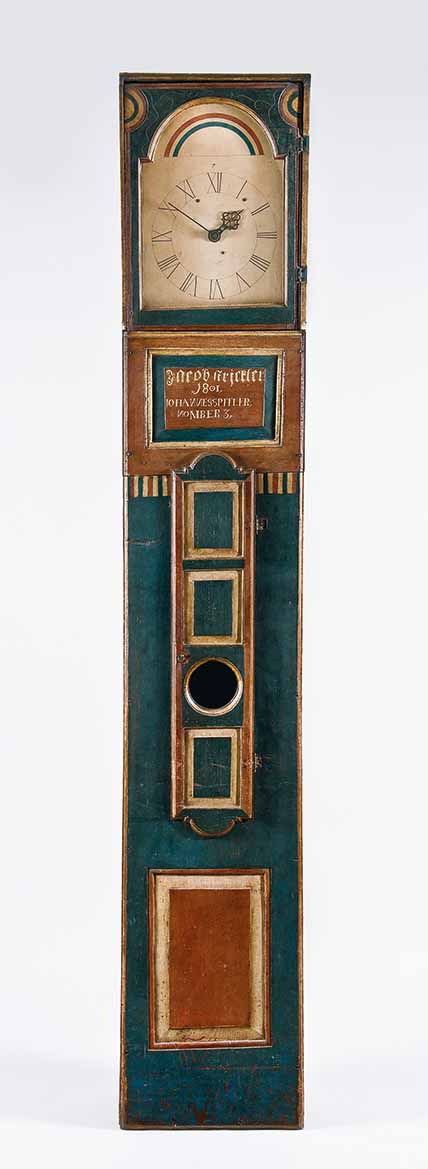

Johannes (or John) Spitler was born on October 2, 1774, the son of Jacob Spitler of Mill Creek, Shenandoah County, Virginia.[1] This specific region of the Valley of Virginia (now in Page County) was known in the eighteenth century as Massanutten, a reference to the fertile river-bottom land between Massanutten Mountain (then called Buffalo Mountain) and the Shenandoah River, near what is now Luray, Virginia. The area had been settled by 1733 by a group of fifty-one German and Swiss pioneers from Lancaster County, Pennsylvania, but, nevertheless, the furniture by Spitler reflects a strong individuality most likely enhanced by the geographic and social isolation of Massanutten itself. As a group, now totaling more than twenty known pieces, the furniture decorated by Spitler forms one of the most concise units of decorated furniture style to be recorded to date.
Although two important tall case clocks by Spitler have been documented, the majority of his work consists of full-size blanket chests (some with a tier below of two side-by-side drawers) and a few smaller-size storage chests. It is not known if Spitler actually built the furniture, which is made primarily of yellow pine and is fairly consistent in construction details, foot profiles, and hardware. Spitler’s painted designs range from geometric—checkerboard, diamond, candy-stripe, grid patterns, and simple compass work, such as pinwheels—to representational motifs, primarily stylized hearts, flowers, and birds. Growth is an important quality in all of these highly structured schemes. Elements continually build upon themselves, but through symmetry and geometry they maintain a certain purity and balance. In all his pieces Spitler seems to have been fascinated with additive designs, compartmentalization, positive-negative relationships, bold contrasts, and playful reversals. He was a master of stylization.
Spitler’s palette did not vary; the colors he used were black, white, red, and blue.[2] The outlines of motifs were incised into the wood itself, precisely defining shapes, but heavy brushstrokes and fairly thick paint reveal the somewhat haphazard way in which he filled in the designs. Spitler signed and inscribed his pieces in a distinctive manner; of the furniture that is signed, most display an abbreviated contraction of his initials: “j.SP.” Additionally, x’s are used to flank or separate letters or words. In several, but not all, cases, the n’s in inscriptions are written backward. The sequence of a consecutive numbering system, apparently one for clocks and another for chests, has yet to be fully explained. Although it was thought until recently that most of Spitler’s furniture had remained in Virginia, close to where it was made, at least two pieces have turned up in Ohio. Spitler, in fact, moved to Fairfield County, Ohio, sometime between 1805 and 1809 but well after most of the dated pieces that have been recorded were painted. He died there on April 18, 1837.
1. For a thorough discussion of Spitler, see Donald Walters, “Johannes Spitler, Shenandoah County, Virginia, Furniture Decorator,” The Magazine Antiques 108, no. 4 (October 1975): 730–735.
2. Ibid., 733, 735.
3. The paint on the three Spitler pieces cataloged here was analyzed using Fourier transform infrared microspectroscopy by Orion Analytical, L.L.C., Williamstown, MA, August 2000. The pigments tested were identified as lead white, red lead, and Prussian blue.
Source: Stacy C. Hollander, American Radiance: The Ralph Esmerian Gift to the American Folk Art Museum (New York: Harry N. Abrams in association with American Folk Art Museum, 2001), 469.